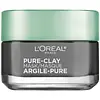What's inside
What's inside
 Key Ingredients
Key Ingredients

 Benefits
Benefits

 Concerns
Concerns

 Ingredients Side-by-side
Ingredients Side-by-side

Water
Skin ConditioningKaolin
AbrasiveBentonite
AbsorbentSulfur
AntiseborrhoeicPropylene Glycol
HumectantTitanium Dioxide
Cosmetic ColorantGlycerin
HumectantCetyl Alcohol
EmollientParaffinum Liquidum
EmollientNiacinamide
SmoothingSodium Acrylates Copolymer
Stearyl Alcohol
EmollientPhenoxyethanol
PreservativeElaeis Fruit Oil
EmollientTocopheryl Acetate
AntioxidantAcacia Senegal Gum
MaskingXanthan Gum
EmulsifyingCocamidopropyl Betaine
CleansingSodium Cocoyl Taurate
CleansingCaprylyl Glucoside
CleansingBHT
AntioxidantDisodium EDTA
Allantoin
Skin ConditioningWater, Kaolin, Bentonite, Sulfur, Propylene Glycol, Titanium Dioxide, Glycerin, Cetyl Alcohol, Paraffinum Liquidum, Niacinamide, Sodium Acrylates Copolymer, Stearyl Alcohol, Phenoxyethanol, Elaeis Fruit Oil, Tocopheryl Acetate, Acacia Senegal Gum, Xanthan Gum, Cocamidopropyl Betaine, Sodium Cocoyl Taurate, Caprylyl Glucoside, BHT, Disodium EDTA, Allantoin
Water
Skin ConditioningKaolin
AbrasiveMontmorillonite
AbsorbentLecithin
EmollientPolysorbate 20
EmulsifyingButylene Glycol
HumectantPropylene Glycol
HumectantGlycol
HumectantCI 77499
Cosmetic ColorantOryzanol
Skin ConditioningOryza Sativa Starch
AbsorbentMoroccan Lava Clay
AbrasiveCharcoal Powder
AbrasiveCaprylyl Caprylate
EmollientCitric Acid
BufferingXanthan Gum
EmulsifyingPolyglycerin-10
HumectantPolyglyceryl-10 Myristate
Skin ConditioningPolyglyceryl-10 Stearate
Skin ConditioningSodium Dehydroacetate
PreservativePhenoxyethanol
PreservativeChlorphenesin
AntimicrobialLinalool
PerfumingLimonene
PerfumingParfum
MaskingWater, Kaolin, Montmorillonite, Lecithin, Polysorbate 20, Butylene Glycol, Propylene Glycol, Glycol, CI 77499, Oryzanol, Oryza Sativa Starch, Moroccan Lava Clay, Charcoal Powder, Caprylyl Caprylate, Citric Acid, Xanthan Gum, Polyglycerin-10, Polyglyceryl-10 Myristate, Polyglyceryl-10 Stearate, Sodium Dehydroacetate, Phenoxyethanol, Chlorphenesin, Linalool, Limonene, Parfum
 Reviews
Reviews

Ingredients Explained
These ingredients are found in both products.
Ingredients higher up in an ingredient list are typically present in a larger amount.
Kaolin is a clay. It is used for oil control and to help minimize pores. Like other clays, kaolin has the ability to absorb excess sebum or oil. This can help clean out pores and mattify the skin.
Some types of kaolin may have exfoliating properties. When water is added to kaolin, it becomes a paste with small abrasive particles.
Most kaolin is a white color, but may be pink/orange/red depending on where it comes from.
The name 'kaolin' comes from a Chinese village named 'Gaoling'. Kaolin clay comes from rocks rich in kaolinite. Kaolinite, the mineral, has a silicate layered structure. Kaolinite is formed from chemical weathering of aluminum siilicate minerals.
Besides skincare, kaolin is commonly used to make glossy paper, in ceramics, toothpaste, and as medicine to soothe stomach issues.
Learn more about KaolinPhenoxyethanol is a preservative that has germicide, antimicrobial, and aromatic properties. Studies show that phenoxyethanol can prevent microbial growth. By itself, it has a scent that is similar to that of a rose.
It's often used in formulations along with Caprylyl Glycol to preserve the shelf life of products.
Propylene Glycol is an odorless, colorless liquid. As a humectant, it helps skin retain moisture. It also aids in delivering active ingredients.
Another role of this ingredient is preventing a product from melting or freezing. Propylene glycol also adds antimicrobrial properties to a product, elongating product lifespan.
This ingredient is considered an organic alcohol and commonly added into both cosmetics and foods.
Those with sensitive skin or conditions may develop a rash when using this ingredient.
Learn more about Propylene GlycolWater. It's the most common cosmetic ingredient of all. You'll usually see it at the top of ingredient lists, meaning that it makes up the largest part of the product.
So why is it so popular? Water most often acts as a solvent - this means that it helps dissolve other ingredients into the formulation.
You'll also recognize water as that liquid we all need to stay alive. If you see this, drink a glass of water. Stay hydrated!
Learn more about WaterXanthan gum is used as a stabilizer and thickener within cosmetic products. It helps give products a sticky, thick feeling - preventing them from being too runny.
On the technical side of things, xanthan gum is a polysaccharide - a combination consisting of multiple sugar molecules bonded together.
Xanthan gum is a pretty common and great ingredient. It is a natural, non-toxic, non-irritating ingredient that is also commonly used in food products.
Learn more about Xanthan Gum